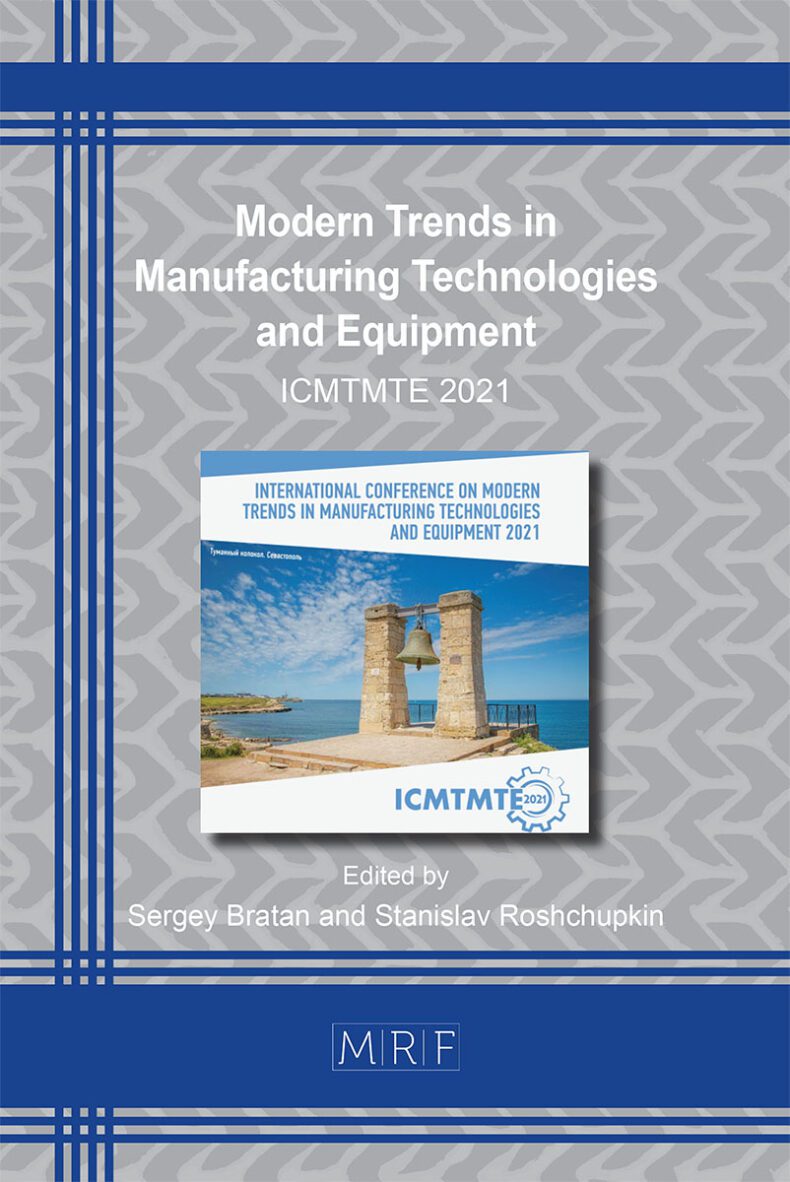Automatic Control System for Bodies of Revolution Processing
Oleg I. Drachev, Boris M. Gorshkov, Natalia S. Samokhina
download PDFAbstract. This research is related to metalworking processing of bodies of revolution with the help of universal lathe machines. The technology includes the application of two types of vibrations to the working tool and the processed surface error measurement. To increase the manufacturing accuracy, the workpiece processed surface error is measured while a workpiece is being rotated; this rotation is performed with the workpiece being rigidly fixed in end supports and at the same time being damped in the sections between these supports. Furthermore, the parameters of vibrations applied to the tool working travel are defined by the workpiece form error and the nature of distribution of stresses that appear when the workpiece is fixed; the nature of the workpiece processed surface form error is extrapolated from the data obtained in the workpiece sections between the supports. Before manufacturing, the workpiece is corrected while being fixed in rigid supports, and the correction itself is performed as the function of magnitude and vector of the workpiece maximum deflection plane. The workpiece may be fixed in rigid supports; steady rests with double rollers may be used as such supports. The workpiece dampening in its sections between end supports may be performed using self-centering steady rests.
Keywords
Metalworking Processing of Bodies, Self-Centering Steady Rests, Automatic Control System, Manufacturing Non-Rigid Shaft-Type Parts, Level of Residual Stresses
Published online 1/5/2022, 7 pages
Copyright © 2022 by the author(s)
Published under license by Materials Research Forum LLC., Millersville PA, USA
Citation: Oleg I. Drachev, Boris M. Gorshkov, Natalia S. Samokhina, Automatic Control System for Bodies of Revolution Processing, Materials Research Proceedings, Vol. 21, pp 310-316, 2022
DOI: https://doi.org/10.21741/9781644901755-55
The article was published as article 55 of the book Modern Trends in Manufacturing Technologies and Equipment
![]() Content from this work may be used under the terms of the Creative Commons Attribution 3.0 licence. Any further distribution of this work must maintain attribution to the author(s) and the title of the work, journal citation and DOI.
Content from this work may be used under the terms of the Creative Commons Attribution 3.0 licence. Any further distribution of this work must maintain attribution to the author(s) and the title of the work, journal citation and DOI.
References
[1] Solomentsev Y.M., Mitrofanov V.G., Protopopov S.P. and others. Adaptive process control. Moscow: Mashinostroenie, 1980.
[2] Drachev O.I. Manufacturing techniques for low-stiff axisymmetric parts. Saint Petersburg: Politekhnika, 2005.
[3] Drachev O.I. &Kravtsov A.N. Automatic control of the process of low-stiff parts turning. Togliatti: VSTU, ZAO «ONIKS», 2012.
[4] Artamonov E.V., Tveryakov A.M., Shtin A.S. Definition of the temperature of the ultimate operational capability of instrumental hard alloys. Obrabotkametallov (tekhnologia, oborudovanie, instrumenty) – Metals processing (Technology, Equipment, Tools), vol. 20 (2018) 47-57.
[5] Bobrowski A.V., Drachev O.I., Gorshkov B.M. Improving the operational accuracy of shafts by volumetric plastic deformation. Available online, 2020. https://doi.org/10.1016/j.matpr.2020.01.458
[6] Zakovorotniy V.L., Voloshin D.A., Rodriges S.B., Flek M.B. Method of modeling elastic deformations of cylindrical end mills in the process of milling. Investigation of machines and tools for machining complex and precise surfaces. Saratov: SSTU, 2003.
[7] Vladimirov A.A. &Sergiev A.P. Influence of vibrational amplitude on component functions of the complex vibrational effect of low-frequency vibrations. IzvestiyaVolgGTU – The Bulletin of VolgGTU, 7 (2018) 13-17.
[8] Zakovorotniy V.L., Ladnik I.V., Dhande S.G. A method for characterization of machine-tools dynamic parameters for diagnostic purposes. Journal of Materials Processing Technology, vol. 53, 1995. https://doi.org/10.1016/0924-0136(94)01745-M
[9] Zakovorotniy V.L. &Bordatchev E.V. Computer aided system for analysis of the cutting motion nonunformity during machine tool approval tests. Modelling, Measurement and Control B, AMSE Press, vol. 56 (3), 1994.
[10] Bobrovsky A. V., Drachev O.I., Kravtsov A.Р. Improving the accuracy and quality of machining by controlling the cutting process, IOP Conference Series: Materials Science and Engineering 709 (2020) 044088. https://doi.org/10.1088/1757-899X/709/4/044088
[11] Palagnyuk G.G. Theoretical substantiation of the method of reducing the energy intensity of the cutting process and its multiparameter active control. Diagnostics and control in technical systems (1995) 74 – 82.
[12] Starkov V.K. Machining, stability and quality management in automated production. Moscow: Mashinostroenie, 1989
[13] Chemavskiy F.G. Modern trends in the construction of precast cutters with non-reversible plates, Review. Moscow: NIIMash, 1983
[14] Savilov A.V., Svinin V.M., Timofeev S.A. Investigation of output parameters of titanium reverse turning. Journal of Physics: Conference Series. International Conference “Information Technologies in Business and Industry” 2018 – Enterprise Information Systems. https://doi.org/10.1088/1742-6596/1015/4/042055
[15] Svinin V.M., Samsonov A., Savilov A.V., Pyatykh A. (2018). Self-oscillation suppression when turning non-rigid shafts using spring tools and the spring headstock center. MATEC Web of Conferences, vol. 224 (2018) 01059. https://doi.































